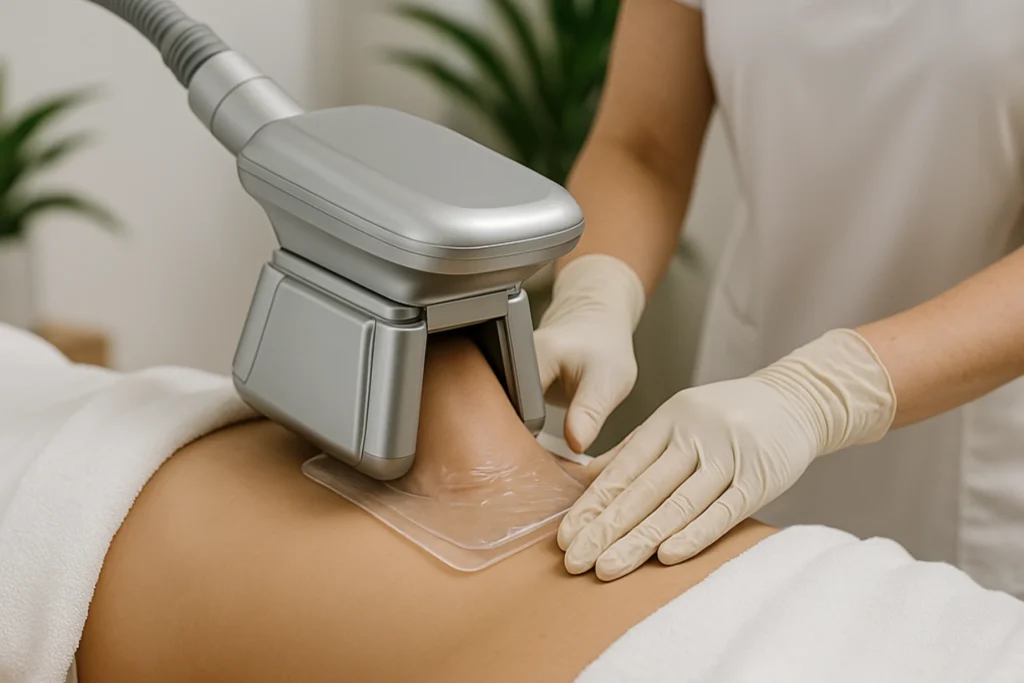Cryolipolysis — or fat freezing, as it is popularly known — is a common, minimally invasive fat-reduction treatment. Advertised as a safe and effective way to eliminate stubborn pockets of obesity, the technique uses controlled cooling to kill fat cells. While cryolipolysis is a safe procedure, it carries some risk. Some experience mild side effects, while others suffer from rare but serious complications.
If you’re thinking about fat freezing, here’s what you need to know about the potential cryolipolysis dangers, risks, and side effects. Here’s what to know about harmless, temporary pain and more serious issues caused by cryolipolysis.
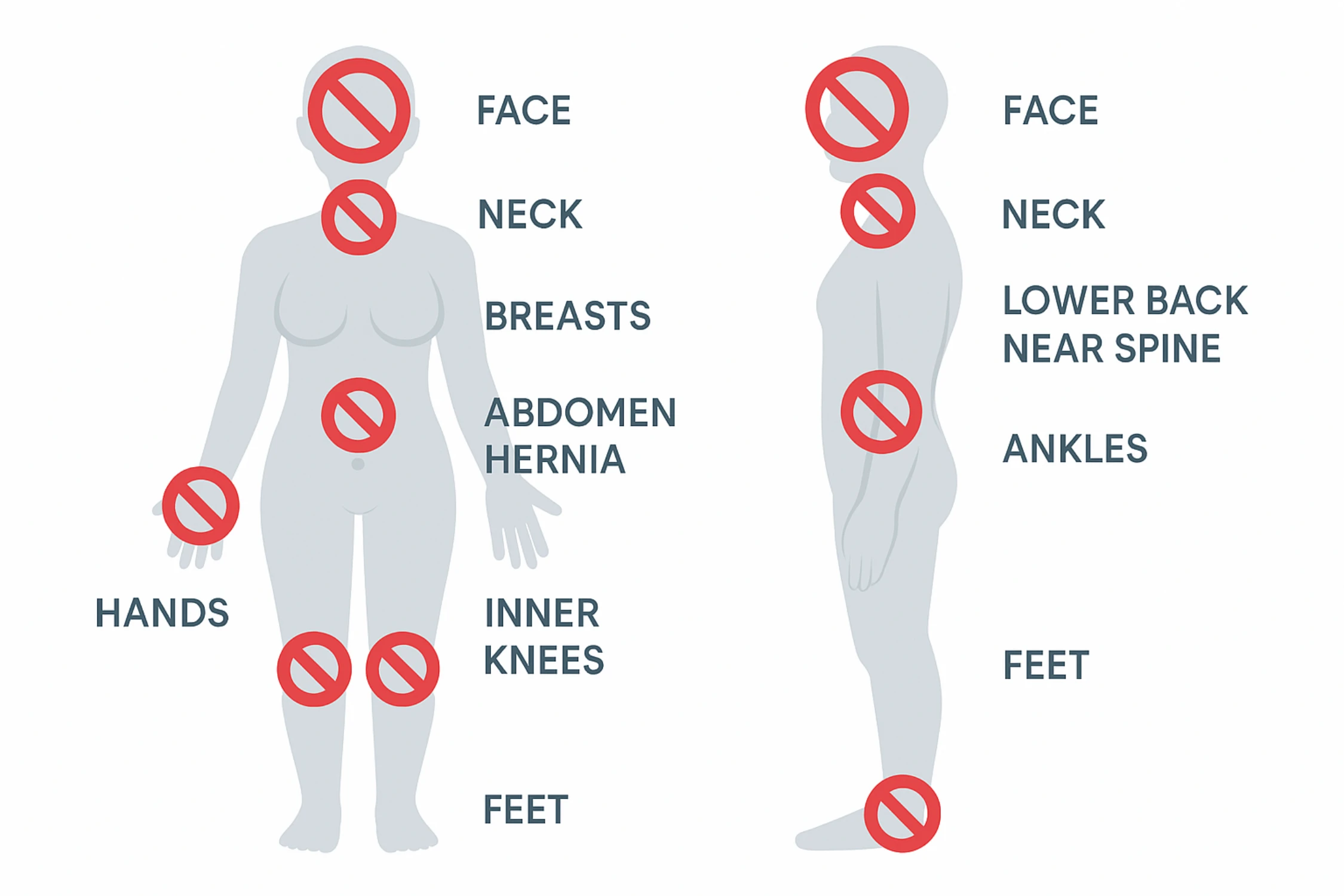
In What Areas Should Cryolipolysis Not Be Done?
Cryolipolysis is not possible on certain areas due to safety concerns and the risk of complications. Here are some high-risk locations:
Unsafe or High-Risk Areas
- Face and Neck: The skin and tissues in these areas are too thin and at risk for frostbite or nerve damage.
- Breasts & Chest: Cryolipolysis is not intended for breast tissue; uneven fat removal can occur leading to complications.
- Lower Back Near the Spine: In this area, cooling may affect nerves, leading to discomfort or even long-term numbness.
- Hands & Feet: These locations are low in fat content and sensitive to the effects of the cold.
- Inner Knees: The lack of a significant fat layer and the proximity to joints make this an unsuitable area.
- Ankles & Wrists: Just like hands and feet, there is not enough fat here to treat with vibrations, which can result in low circulation.
- Abdomen with Hernia: If you have an umbilical or abdominal hernia, cryolipolysis should be avoided.
Sensitive or Medical Concerns Areas
- Tattoo: In extreme cold tattoos may distort or damage tattoo pigments.
- Over Surgical Scars or Recent Incisions: Cryolipolysis can influence healing and potentially result in complications.
- Poor Circulation/Nerve Disorders: Patients with certain health conditions (diabetes and neuropathy for example) should not seek cryolipolysis treatment for impacted areas.
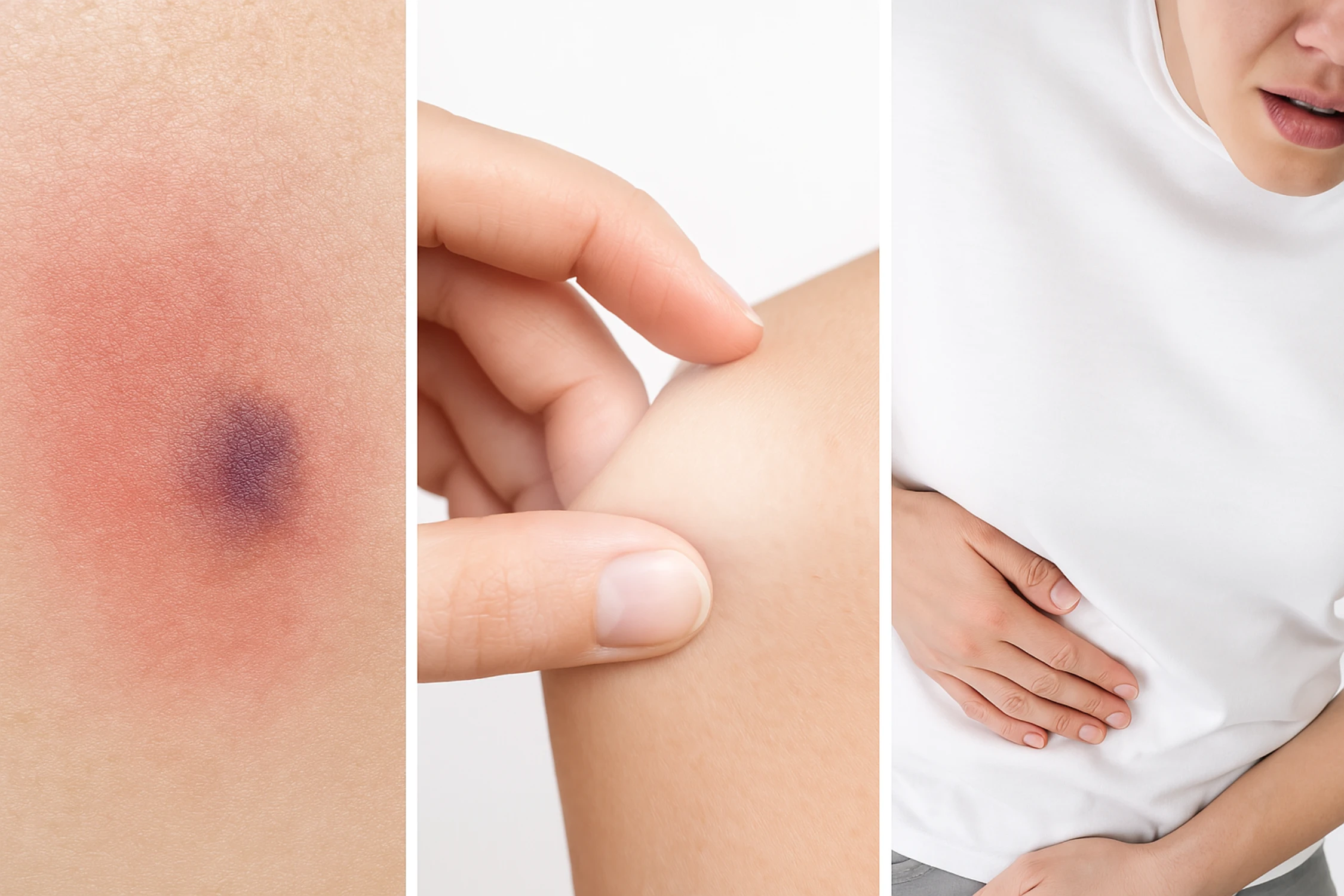
Common Side Effects Of Cryolipolysis
The side effects of a cryolipolysis treatment are typically mild and transient. These usually go away on their own over a matter of days or weeks. Common side effects include:
- Increased Swelling, Redness, and Bruising
Suction is applied during the procedure, which can make the area red, swollen, and even bruised. This response is harmless and resolves over a few days.
- Numbness/Tingling Sensations
Cryolipolysis requires applying extreme cold to fat cells, which can temporarily numb the skin and nearby tissues. Some patients say they experience tingling or altered sensation for weeks after treatment.
- Mild Pain or Discomfort
It may start to feel achy or crampy as the body starts to metabolize the frozen fat cells. This discomfort is typically mild and can be managed without medication.
- Skin Sensitivity
Some people develop heightened sensitivity or tenderness in the area being treated. It can also cause a temporary discomfort when wearing tightly-fitting clothing.
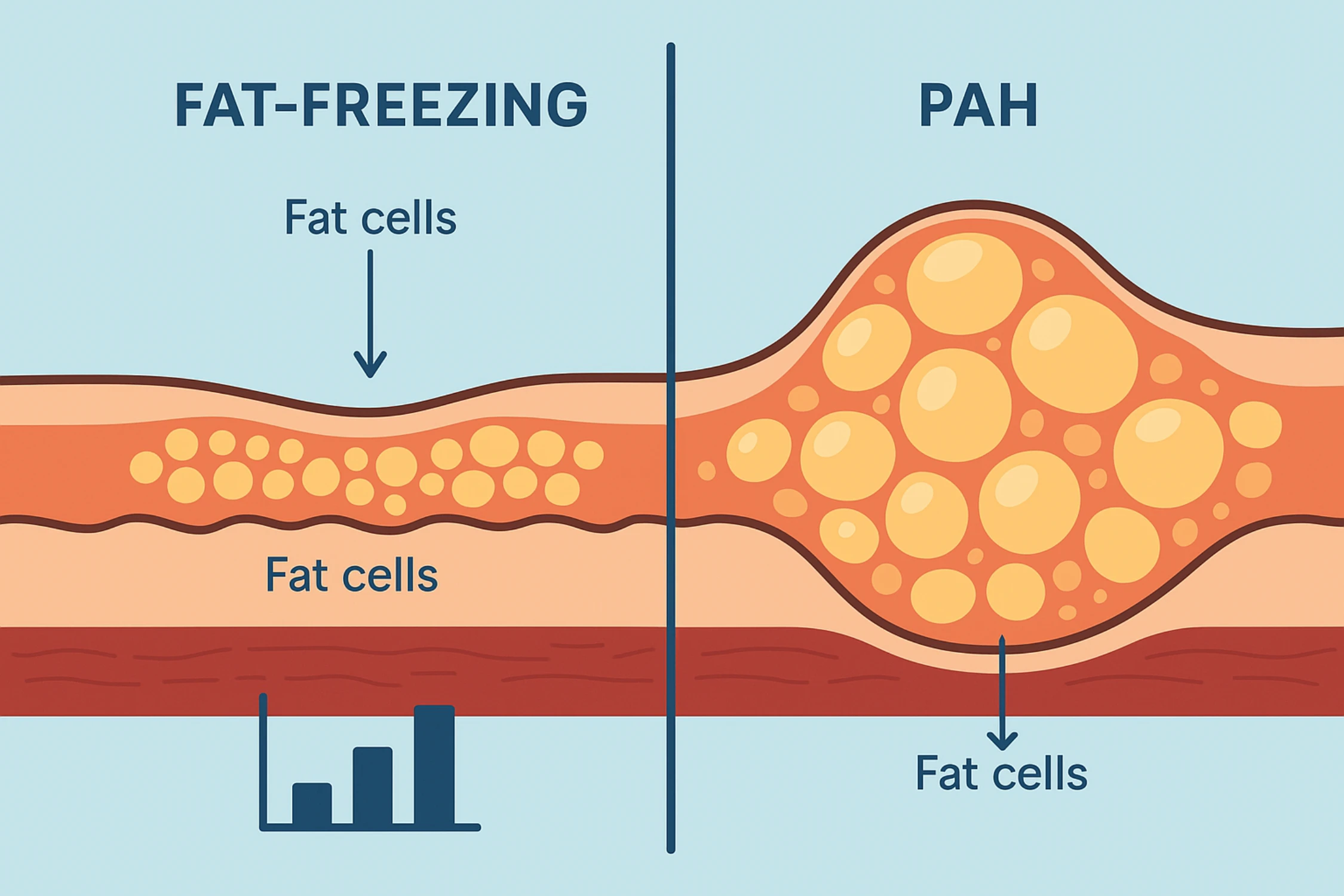
Rare But Serious Risks of Cryolipolysis
While most side effects are mild, there are rare but more serious risks to be aware of. They include more severe side effects that may need medical attention.
Paradoxical Adipose Hyperplasia (PAH)
Paradoxical adipose hyperplasia — or PAH — is one of the rare but serious cryolipolysis dangers. This condition makes the fat cells expand rather than break down, thus increasing the amount of fat volume. Men are more frequently affected by PAH which is often surgically corrected.
- Frostbite or Skin Damage
Cryolipolysis is intended to cool fat cells without harming. However, there is a risk with improper application that is too aggressive or skin that is too sensitive, which could result in frostbite and/or tissue death. This risk is greatly diminished when a qualified professional performs the procedure.
- Uneven Fat Reduction
Fat can be removed in unequal amounts, which may give an asymmetrical or irregular appearance. Such crestfallen expectations can be disappointing for patients hoping for smooth, natural-looking results.
- Long-Term Nerve Damage
Rarely, it can cause nerve damage, resulting in numbness or changed sensations in the treated area that linger for weeks or longer. Most cases improve with time, but a proportion of patients can develop longer-term changes.
- Digestive Discomfort
As the body flushes away the destroyed fat cells via the lymphatic system, some patients experience mild digestive problems, like bloating or an upset stomach.
How Long Do Cryolipolysis Side Effects Last?
Cryolipolysis side effects can differ among individuals; however, the majority are mild and short-lived. Here is a summary of how long they typically last:
Common Side Effects & Duration
- Redness & Swelling: Hours to a Few Days
- Bruising: 1 to 2 weeks (intensely larger common in sensitive skin)
- Numbness & Tingling: From a few days to several weeks (some have reported as long as 6 weeks)
- Mild Pain or Soreness: A few days to a week
- Skin Sensitivity: Up to a few weeks
Rare But Serious Side Effects & Duration
- Paradoxical Adipose Hyperplasia (PAH): Permanent unless treated surgically
- Nerve Pain or Prolonged Numbness: Several weeks to months (rare cases)
- Uneven Fat Reduction or Lumps: These may be long-term if not corrected.
Most people have no complications, can heal, and get back to doing normal activities immediately. But if you experience an extreme level of pain, excessive swelling, or prolonged numbness, and those symptoms last longer than you would expect, it’s best to consult a doctor.
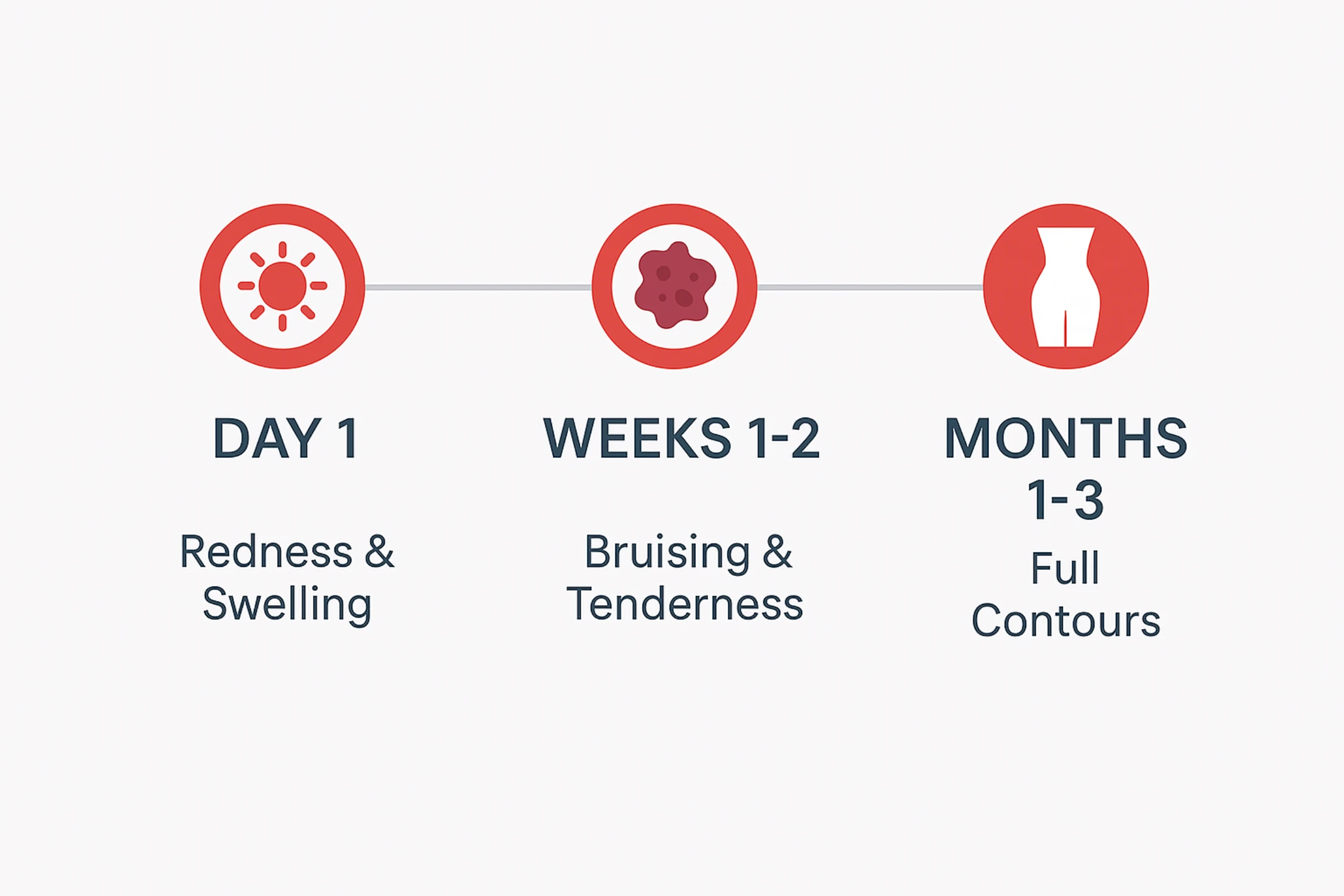
What to Expect After Cryolipolysis?
As part of a natural fat elimination process following cryolipolysis, the fat makes its way out of your body. Although there are no side effects, you could experience some temporary side effects. Here is what you can expect:
Right After the Procedure
- Slight Redness & Swelling: The treatment area may be red, swollen or tender from the cooling a nd suction.
- Temporary Numbness: Many patients describe numbness or tingling in the area.
- Firmness or Hardened Skin: The treated fat may feel firm or lumpy, but this feeling will fade as those fat cells are processed by the body.
First Few Days to Weeks
- Bruising & Tenderness: Some people report mild bruising or tenderness, similar to post-workout soreness.
- Itching & Skin Sensitivity: As the nerves in the treated area heal, a mild itching sensation can occur.
- Fat Reduction Progresses: The frozen fat cells begin to be metabolized and excreted by your body through the lymphatic system.
1 — 3 months after treatment
- Significant Fat Loss: Average users see fat loss in 4 – 6 weeks, with full results in 2 – 3 months.
- More Contours: The treated area appears more sculpted and toned, eliminating fat cells.
- Low Maintenance Required: After fat cells are removed, they don’t return, however, it is advised to maintain healthy habits to maintain results.
Although uncommon, if you have severe pain, excessive swelling or nonregular lumps that do not resolve within a few weeks, visit your provider
How To Accelerate Your Cryolipolysis Results?
Although cryolipolysis gradually gets rid of all the fat, it freezes over 2 to 3 months, there are certain things you can do to help your body process the destroyed fat cells more quickly. Here is how to expedite your results:
- Stay Hydrated
Staying hydrated also helps your lymphatic system do its job of flushing out dead fat cells more readily. Strive for 8 or more glasses of water daily to foster detoxification.
Massage the Treated Area
Research shows that a 2-minute massage immediately after treatment can boost fat loss by up to 68%. At home gentle massaging can continue to better circulation but also to help you eliminate the fat.
- Stay Active in Life
Exercise increases circulation and metabolism, which means your body will process fat cells quicker. You do not need hard workouts, daily walks, strength training or yoga; can all do the trick.
- Eat a Healthy Diet
Eat a diet rich in unprocessed foods and low in sugar to prevent new fat from accumulating. Focus on:
- Low-fat protein (chicken, fish, tofu)
- Healthful fats (avocados, nuts, olive oil)
- High-fiber foods (vegetables, whole grain)
- Say No to Alcohol and Smoking
Alcohol and smoking slow down the process of lymphatic drainage, where the fat needs to be disposed of, which can delay the process of fat elimination. Taking back can help your body absorb results faster.
- Wear Compression Garments
Patients who wear compression garments often note reduced swelling and circulation of blood flow in the treated area, which could improve their results.
Consider Additional Treatments
For those looking for faster or enhanced results, treatments like radio frequency (RF) skin tightening or lymphatic drainage massage can help.
Who Is a Good Candidate for Cryolipolysis?
Although cryolipolysis is known as a harmless and generally popular treatment, its effects can increase if you have specific body features. A good candidate for cryolipolysis is someone who:
- Have Stubborn Fat Deposits: The best candidates have pockets of fat that are not responsive to diet and exercise, like love handles, lower abdominal fat or thigh fat.
- Close to Their Desired Weight: Cryolipolysis is a body-contouring treatment, not a weight loss treatment. It is most effective for those who are at or are close to achieving their ideal body weight but have stubborn areas.
- Has Good Skin Elasticity: People with firm and elastic skin usually get the best results, as loose or sagging skin will not tighten properly after fat removal.
- Is in Generally Good Health: Best candidates for this do not have underlying conditions that impair healing or fat metabolism.
- Has Realistic Expectations: Cryolipolysis destroys about 20-25% of fat cells in treated areas, which doesn’t equate to dramatic weight loss.
Who Should Avoid Cryolipolysis?
Cryolipolysis is not for everyone. Some people should not have this procedure because of a higher risk of complications. You are probably not a good fit if you:
- Have pulmonary arterial hypertension or are at increased risk for the disease
- Have cryoglobulinemia or cold agglutinin disease
- Have loose or hanging skin in the area being treated.
- Are pregnant or breastfeeding
- Have an active skin infection or injury at the treatment site
Consulting with a qualified medical professional is crucial before undergoing cryolipolysis to ensure that it is safe for your specific needs.
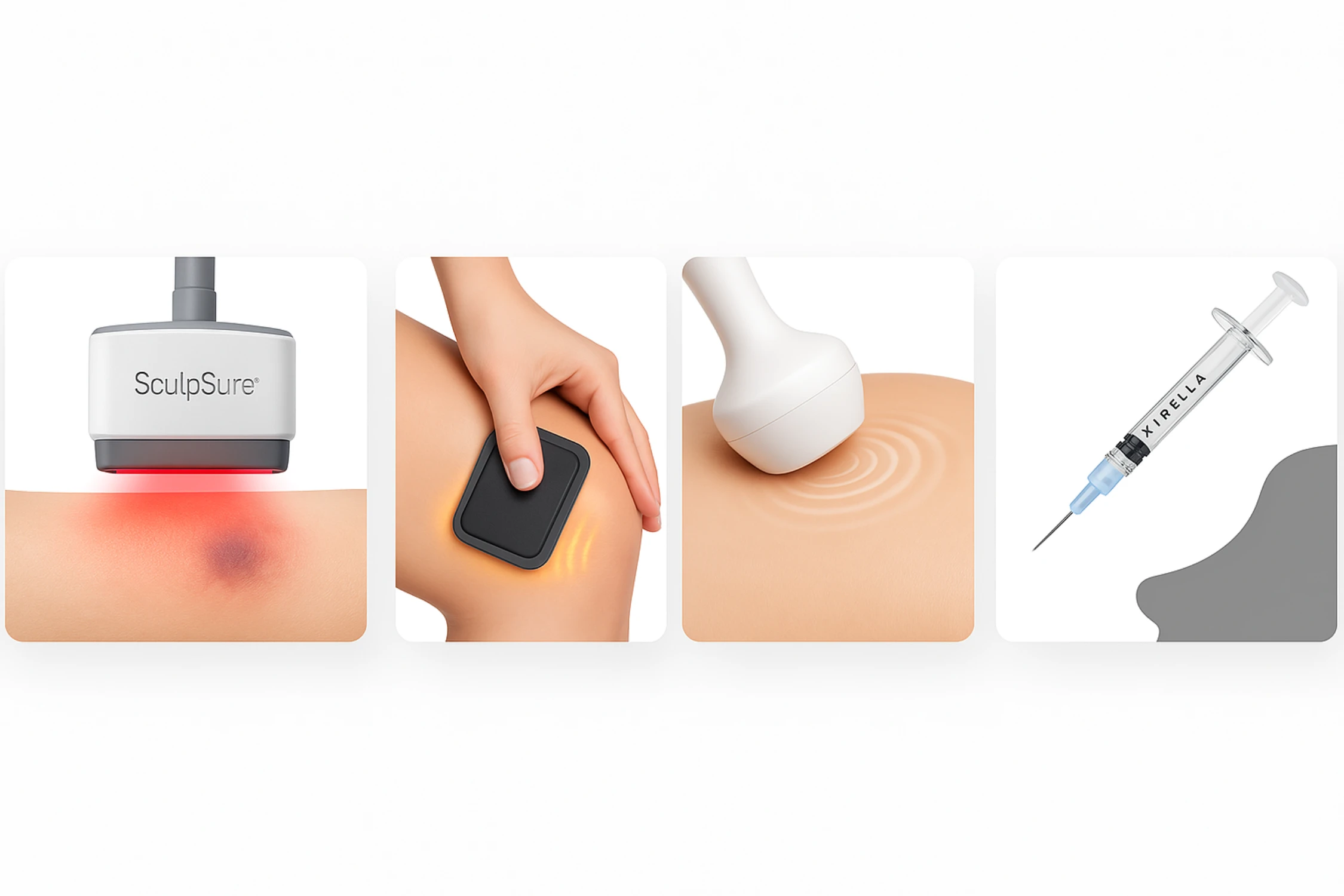
Cryolipolysis Alternatives: Effective Non-Surgical Fat Reduction Options
Although Cryolipolysis is popular for reducing fat, it’s not the only option. Here are some non-invasive options you can try for a toned and slimmer contour look.
- Laser Fat Reduction (SculpSure)
Employs laser heat to obliterate fat cells while preserving the integrity of the skin. The procedure is around 25 minutes long, with results noticeable within 6-12 weeks. Best for small fat pockets.
- RF (Radio Frequency) Fat Reduction
Fires RF energy to dissolve fat and tighten skin. Good for skin laxity post-weight loss. It is a non-invasive, painless treatment that results in just 4-6 weeks.
- Ultrasound Fat Reduction (UltraShape, Liposonix)
Ultrasound waves are used to break down fat cells, which over time reduces the fat layers. Great for large areas such as the stomach or thighs. Results can be seen in 8-12 weeks.
- Injectable Fat Dissolvers (Kybella, Aqualyx)
These deoxycholic acid injections permanently melt fat cells. Most commonly used for double chin and small fat deposits. Mild swelling develops, and results show at 4-6 weeks.
- Hands-Free Muscle Toning (Emsculpt, Evolve Tone)
Employs electromagnetic pulses to develop muscle and decrease fat at the same time. Great for toning abs, butt, and thighs. You see results in 4-8 weeks.
Is Cryolipolysis Worth It?
Although cryolipolysis removes fat without surgery, it is not free of risk. Understanding the possible cryolipolysis dangers and side effects before making a decision can help you to see if the procedure aligns with your goals. When weighing the benefits against the risks, factors like cryolipolysis cost, its safety, and effectiveness should also be considered. While some may find its convenience and noninvasive makeup compelling, others may be better suited to alternative methods of fat-reduction without the footprint of risk. Ultimately, the decision should be based on thorough research and professional guidance.

